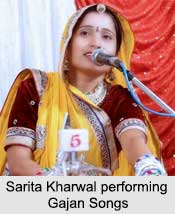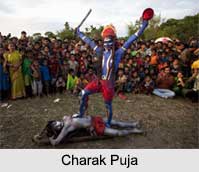 In Bengal, Gajan and Charak set soul in the state of Bengal festivals. Hindus rejoice the festival mostly on the last two days of the month of Chaitra, just by Bengali New Year. Chiefly this falls about mid-April. It is associated with such deities as Shiva, Neel and Dharmathakur. Though it is celebrated mostly in rustic Bengal, the festival is still celebrated in some parts of Kolkata city. It is held that Gajan dance emanated from the system of worship of Dharma Thakur in Radh area, that is, Purulia, Midnapur, Bankura, Burdwan and contiguous areas of Singbhum in Bihar. It ends with Charak Puja.
In Bengal, Gajan and Charak set soul in the state of Bengal festivals. Hindus rejoice the festival mostly on the last two days of the month of Chaitra, just by Bengali New Year. Chiefly this falls about mid-April. It is associated with such deities as Shiva, Neel and Dharmathakur. Though it is celebrated mostly in rustic Bengal, the festival is still celebrated in some parts of Kolkata city. It is held that Gajan dance emanated from the system of worship of Dharma Thakur in Radh area, that is, Purulia, Midnapur, Bankura, Burdwan and contiguous areas of Singbhum in Bihar. It ends with Charak Puja.
Gajan, as a form of music, comprises the loud dance rhythm, played on big drums supporting various physical endeavors of dance of the male folk (those who observe the philosophy of Sanyasis for some period before the festival days), is a peculiar folk festival having its sources in various factors which ultimately combine in a common type of frail musical representation. In fact, it has little importance in respect of music.
Origin of Gajan Song
The festival is essentially linked to farming community, straight or not directly. They pray for the rains and improved crop. Lord Shiva is said to be very much related to this community. However, interestingly it"s broadly believed that the source and the nature of these festivals are connected to the alteration of the Buddhist monks to Hinduism. It slowly transformed into a celebration of Lord Shiva but the Tantric rituals of Buddhism got engrossed in the festivities counting acts of self-punishment as well as the thought of monasticism. Rituals like dance with human skulls, body piercing and fire plays are seen in this time.
The fair which is now called "Shiber Gajan", which strongly means "Lord Shiva`s worshiping and songs", was at one time called "Dharmer Gajan". This Dharmathakur may have been originated from Dharmaraj of Buddhism. Faith relating to the expression of Sun-God is another well-liked idea. On the last day of the month of Chaitra, Gajan fair is observed all over Rarh region. Body-piercing of Sanyasis, revolving known as Charak, dancing in fire, jumping on nail and thorns, etc., are some of the features of the festival. The worship of Dharma Thakur was originally held in the month of Vaisakh.
Celebration of Gajan
Gajan festivity is performed by the devotees telling marriages of the male forces of Shiva, Nil or Dharmaraj with their individual wife. One way it signifies the combination of the forces of sun and earth. On the other hand the custom of Charak Puja is all regarding worshipping the Charak tree and the several self-punishment acts performed by Charak Sanyasis. In Shiva"s Gajan, Shiva is married to Harakali on this day. The sannyasis form the barjatri (bridegroom"s party). In Dharma"s gajan Dharmathakur is married to Mukti. It is believed that these acts of self-punishment in fact functions as a near-role problem for men attempting to practice the pains of womanhood, as well as childbirth. It is assumed that the farming community, which considers the rural soils as mother, believes they communicate hurt to the earth and thus to their mother, during acts like plowing, harvesting, and thus they experience such acts of self-punishment to feel the same quantity of pain.
The major observation of the function relates to the Gajan of Lord Shiva, Dharma and Nilpuja. But, now everywhere worship of Lord Shiva predominates. Gajan songs include invocation of all Gods and Goddesses and elaborate descriptions of various local rituals relating to the ceremony. General criticism of social life also appears as the subject matter, and songs are also sung in question and answer form between two. The music of Gajan is of Pancali type used widely in compositions containing descriptive subject matter. Here is an illustration from a song used by Sanyasis for awakening Siva from sleep. It is virtually a part of a long piece and a salutation offered to all directions: temple, gate, bars, holy tulsi plant, goddess saraswati, Lord Rama, Lakshman, Sita, Hanuman and then Sun-God.




















